Koraller uddøde forudsagt, da hedebølgen i havet opsluger Hawaii
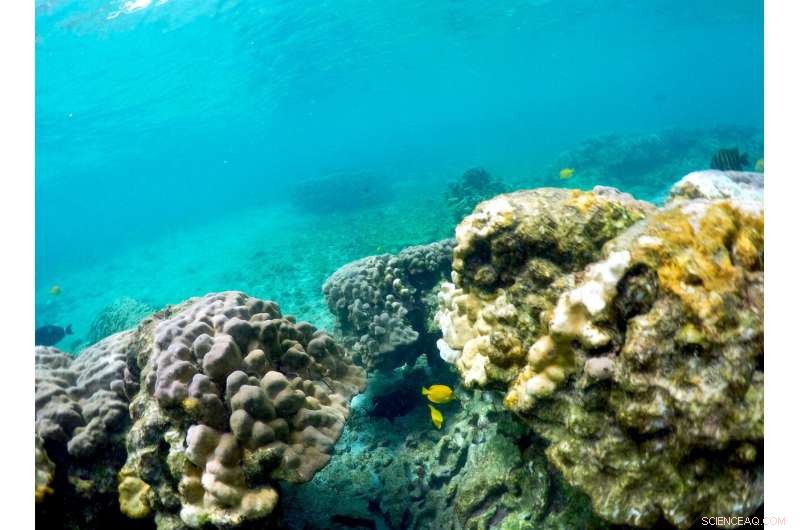
Denne 12. sept. 2019-billede viser blegning af koraller i Kahala'u Bay i Kailua-Kona, Hawaii. Blot fire år efter at en stor hedebølge i havet dræbte næsten halvdelen af denne kystlinjes koraller, Føderale forskere forudser, at endnu en omgang varmt vand vil forårsage noget af det værste koralblegning, som regionen nogensinde har set. (AP Photo/Caleb Jones)
På kanten af en gammel lavastrøm, hvor takkede sorte klipper møder Stillehavet, små huse uden for nettet har udsigt over det rolige blå vand i Papa Bay på Hawaiis Big Island - ingen turister eller hoteller i sigte. Her, et af øernes mest rigelige og levende koralrev trives lige under overfladen.
Men selv denne fjerntliggende kystlinje langt fra virkningerne af kemisk solcreme, trampende fødder og industrispildevand viser tidlige tegn på, hvad der forventes at blive en katastrofal sæson for koraller på Hawaii.
Blot fire år efter at en stor hedebølge i havet dræbte næsten halvdelen af denne kystlinjes koraller, Føderale forskere forudser, at endnu en omgang varmt vand vil forårsage noget af det værste koralblegning, som regionen nogensinde har oplevet.
"I 2015, vi ramte temperaturer, som vi aldrig nogensinde har registreret på Hawaii, " sagde Jamison Gove, en oceanograf hos National Oceanic and Atmospheric Administration. "Hvad er virkelig vigtigt - eller alarmerende, nok mere passende - om denne begivenhed er, at vi har fulgt ovenover, hvor vi var på dette tidspunkt i 2015."
Forskere, der bruger højteknologisk udstyr til at overvåge Hawaiis rev, ser tidlige tegn på blegning i Papa Bay og andre steder forårsaget af en marine hedebølge, der har sendt temperaturer til rekordhøje niveauer i flere måneder. Juni, Juli og dele af august oplevede alle de varmeste havtemperaturer nogensinde registreret omkring Hawaii-øerne. Indtil videre i september, oceaniske temperaturer er kun under dem, der blev set i 2015.

Denne 12. sept. 2019-billede viser fisk nær koraller i en bugt på vestkysten af Big Island nær Captain Cook, Hawaii. Blot fire år efter at en stor hedebølge i havet dræbte næsten halvdelen af denne kystlinjes koraller, Føderale forskere forudser, at endnu en omgang varmt vand vil forårsage noget af det værste koralblegning, som regionen nogensinde har set. (AP Photo/Brian Skoloff)
Prognosefolk forventer, at høje temperaturer i det nordlige Stillehav vil fortsætte med at pumpe varme ind i Hawaiis farvande langt ind i oktober.
"Temperaturerne har været varme i ret lang tid, " sagde Gove. "Det er ikke bare hvor varmt det er. Det er, hvor længe disse havtemperaturer forbliver varme."
Koralrev er livsvigtige rundt om i verden, da de ikke kun giver et levested for fisk - bunden af den marine fødekæde - men også mad og medicin til mennesker. De skaber også en vigtig kystlinjebarriere, der bryder store havdønninger fra hinanden og beskytter tætbefolkede kystlinjer mod stormfloder under orkaner.
På Hawaii, Rev er også en stor del af økonomien:Turisme trives i høj grad på grund af koralrev, der hjælper med at skabe og beskytte ikoniske hvide sandstrande, tilbyde snorkel- og dykkersteder, og hjælpe med at danne bølger, der tiltrækker surfere fra hele verden.

Denne 12. sept. 2019-billede viser blegning af koraller i Kahala'u Bay i Kailua-Kona, Hawaii. Blot fire år efter at en stor hedebølge i havet dræbte næsten halvdelen af denne kystlinjes koraller, Føderale forskere forudser, at endnu en omgang varmt vand vil forårsage noget af det værste koralblegning, som regionen nogensinde har set. (AP Photo/Caleb Jones)
Havets temperaturer er ikke ensartet varme i hele staten, Gove noterede sig. Lokale vindmønstre, strømme og endda funktioner på land kan skabe hot spots i vandet.
"Du har ting som to gigantiske vulkaner på Big Island, der blokerer de fremherskende passatvinde, "gør øens vestkyst, hvor Papa Bay sidder, en af de hotteste dele af staten, sagde Gove. Han sagde, at han forventer "alvorlig" koralblegning de steder.
"Dette er udbredt, 100% blegning af de fleste koraller, " sagde Gove. Og mange af de koraller er stadig ved at komme sig efter blegningsbegivenheden i 2015, hvilket betyder, at de er mere modtagelige for termisk stress.
Ifølge NOAA, hedebølgens årsager omfatter et vedvarende lavtryksvejrmønster mellem Hawaii og Alaska, der har svækket vinde, der ellers kunne blande sig og afkøle overfladevandet over store dele af det nordlige Stillehav. Hvad der forårsager det er uklart:Det kan afspejle atmosfærens sædvanlige kaotiske bevægelse, eller det kan være relateret til opvarmningen af havene og andre effekter af menneskeskabte klimaændringer.
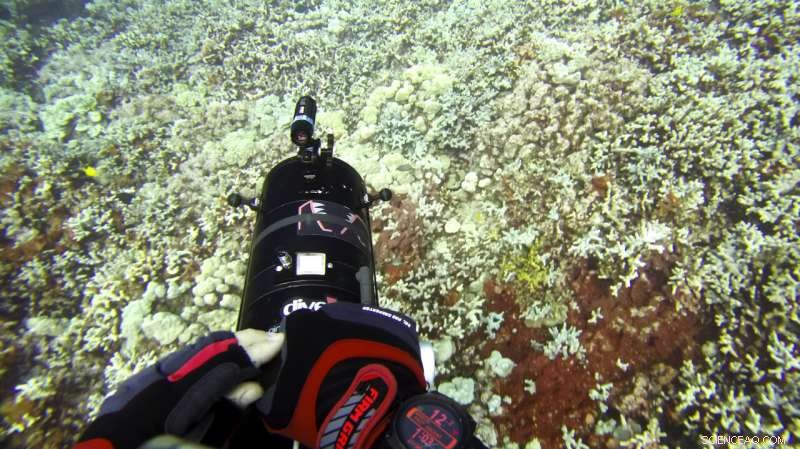
I denne 13. sept. 2019-billede taget fra video leveret af Arizona State University's Center for Global Discovery and Conservation Science, økolog Greg Asner dykker over et koralrev i Papa Bay nær Captain Cook, Hawaii. "Nearly every species that we monitor has at least some bleaching, " Asner said. (Greg Asner/Arizona State University's Center for Global Discovery and Conservation Science via AP)
Beyond this event, oceanic temperatures will continue to rise in the coming years, Gove said. "There's no question that global climate change is contributing to what we're experiencing, " han sagde.
For coral, hot water means stress, and prolonged stress kills these creatures and can leave reefs in shambles.
Bleaching occurs when stressed corals release algae that provide them with vital nutrients. That algae also gives the coral its color, so when it's expelled, the coral turns white.
Gove said researchers have a technological advantage for monitoring and gleaning insights into this year's bleaching, data that could help save reefs in the future.
"We're trying to track this event in real time via satellite, which is the first time that's ever been done, " Gove said.
In remote Papa Bay, most of the corals have recovered from the 2015 bleaching event, but scientists worry they won't fare as well this time.
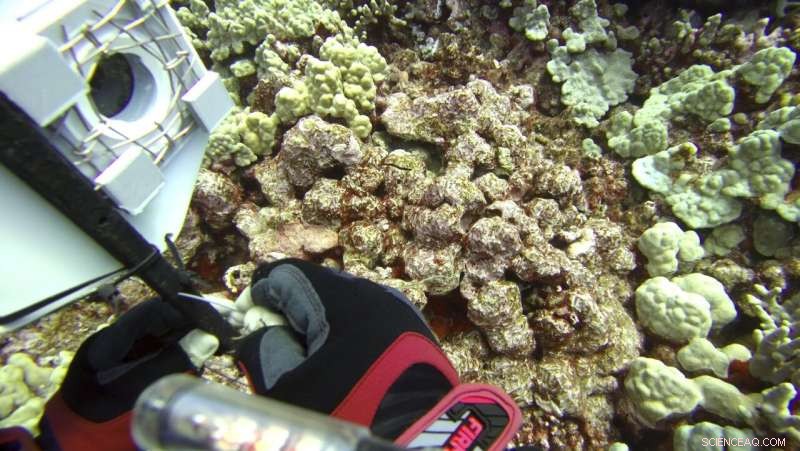
In this Sept. 13, 2019, image taken from video provided by Arizona State University's Center for Global Discovery and Conservation Science, ecologist Greg Asner prepares a camera fish trap on a coral reef in Papa Bay near Captain Cook, Hawaii. "Nearly every species that we monitor has at least some bleaching, " Asner said. (Greg Asner/Arizona State University's Center for Global Discovery and Conservation Science via AP)
"Nearly every species that we monitor has at least some bleaching, " said ecologist Greg Asner, director of Arizona State University's Center for Global Discovery and Conservation Science, after a dive in the bay earlier this month.
Asner told The Associated Press that sensors showed the bay was about 3.5 degrees Fahrenheit above what is normal for this time of year.
He uses advanced imaging technology mounted to aircrafts, satellite data, underwater sensors and information from the public to give state and federal researchers like Gove the information they need.
"What's really important here is that we're taking these (underwater) measurements, connecting them to our aircraft data and then connecting them again to the satellite data, " Asner said. "That lets us scale up to see the big picture to get the truth about what's going on here."

In this Sept. 13, 2019 image taken from video provided by Arizona State University's Center for Global Discovery and Conservation Science, ecologist Greg Asner dives over a coral reef in Papa Bay near Captain Cook, Hawaii. "Nearly every species that we monitor has at least some bleaching, " Asner said. (Greg Asner/Arizona State University's Center for Global Discovery and Conservation Science via AP)
Scientists will use the information to research, blandt andet, why some coral species are more resilient to thermal stress. Some of the latest research suggests slowly exposing coral to heat in labs can condition them to withstand hotter water in the future.
"After the heat wave ends, we will have a good map with which to plan restoration efforts, " Asner said.
I mellemtiden, Hawaii residents like Cindi Punihaole Kennedy are pitching in by volunteering to educate tourists. Punihaole Kennedy is director of the Kahalu'u Bay Education Center, a nonprofit created to help protect Kahalu'u Bay, a popular snorkeling spot near the Big Island's tourist center of Kailua-Kona.
The bay and surrounding beach park welcome more than 400, 000 visitors a year, hun sagde.
"We share with them what to do and what not to do as they enter the bay, " she said. "For instance, avoid stepping on the corals or feeding the fish."
-

In this Sept. 13, 2019 image taken from video provided by Arizona State University's Center for Global Discovery and Conservation Science, ecologist Greg Asner dives over a coral reef in Papa Bay near Captain Cook, Hawaii. "Nearly every species that we monitor has at least some bleaching, " Asner said. (Greg Asner/Arizona State University's Center for Global Discovery and Conservation Science via AP)
-
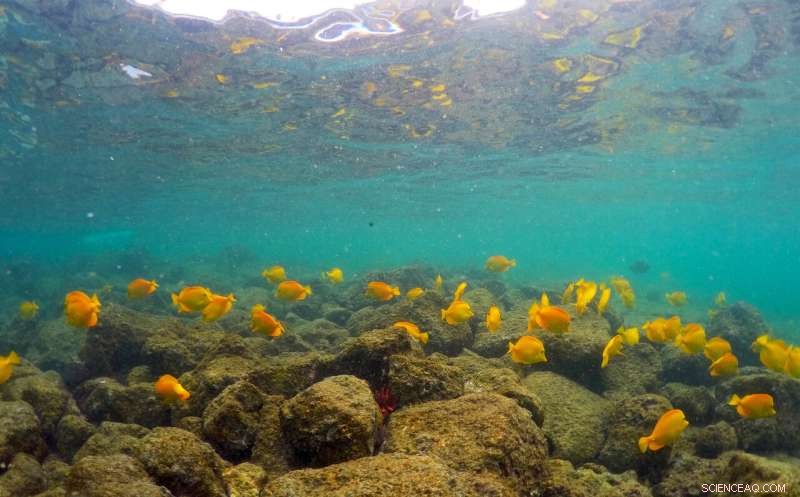
In this Sept. 12, 2019 foto, fish swim near bleaching coral in Kahala'u Bay in Kailua-Kona, Hawaii. Just four years after a major marine heat wave killed nearly half of this coastline's coral, federal researchers are predicting another round of hot water will cause some of the worst coral bleaching the region has ever seen. (AP Photo/Caleb Jones)
-
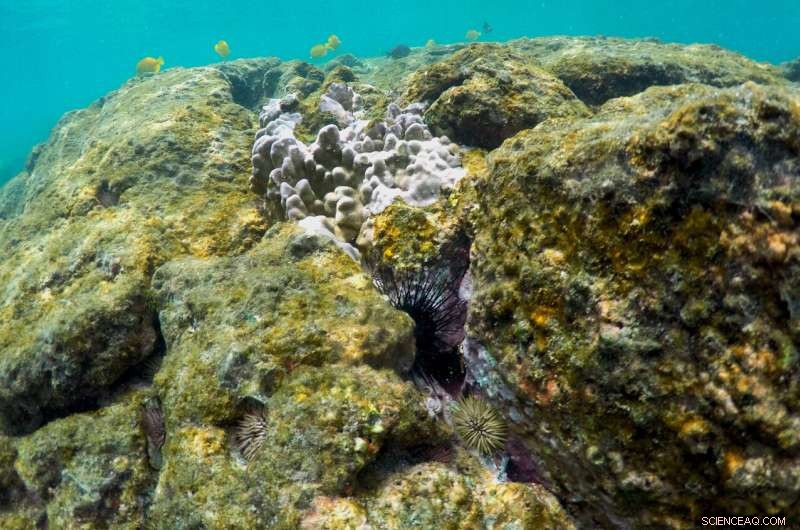
In this Sept. 12, 2019 foto, sea urchins and fish are seen near bleaching coral in Kahala'u Bay in Kailua-Kona, Hawaii. Just four years after a major marine heat wave killed nearly half of this coastline's coral, federal researchers are predicting another round of hot water will cause some of the worst coral bleaching the region has ever seen. (AP Photo/Caleb Jones)
-
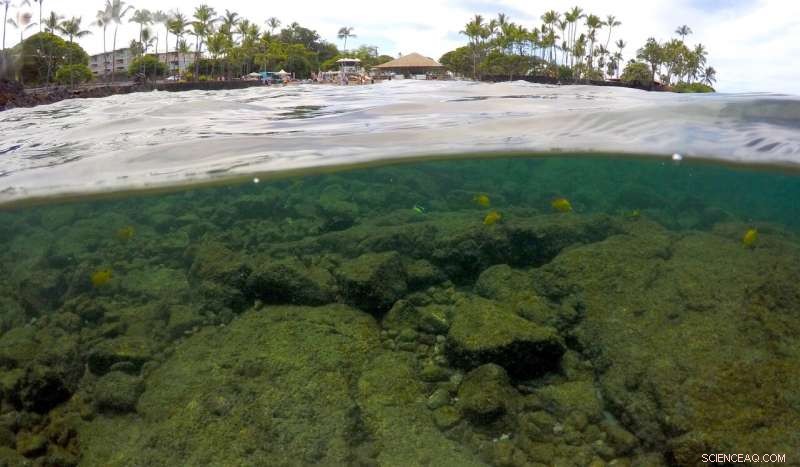
In this Sept. 12, 2019 foto, fish swim near bleaching coral in Kahala'u Bay in Kailua-Kona, Hawaii. Coral reefs are vital around the world as they not only provide a habitat for fish—the base of the marine food chain—but food and medicine for humans. They also create an essential shoreline barrier that breaks apart large ocean swells and protects densely populated shorelines from storm surges during hurricanes. (AP Photo/Caleb Jones)
-

In this Sept. 12, 2019 foto, visitors stand in Kahala'u Bay in Kailua-Kona, Hawaii. Hawaii residents like Cindi Punihaole Kennedy are pitching in by volunteering to educate tourists. Punihaole Kennedy is director of the Kahalu'u Bay Education Center, a nonprofit created to help protect Kahalu'u Bay, a popular snorkeling spot near the Big Island's tourist center of Kailua-Kona. (AP Photo/Caleb Jones)
-

This Sept. 13, 2019 photo shows a chunk of bleached, dead coral shown on a wall near a bay on the west coast of the Big Island near Captain Cook, Hawaii. Coral reefs are vital around the world as they not only provide a habitat for fish—the base of the marine food chain—but food and medicine for humans. They also create an essential shoreline barrier that breaks apart large ocean swells and protects densely populated shorelines from storm surges during hurricanes. (AP Photo/Caleb Jones)
-
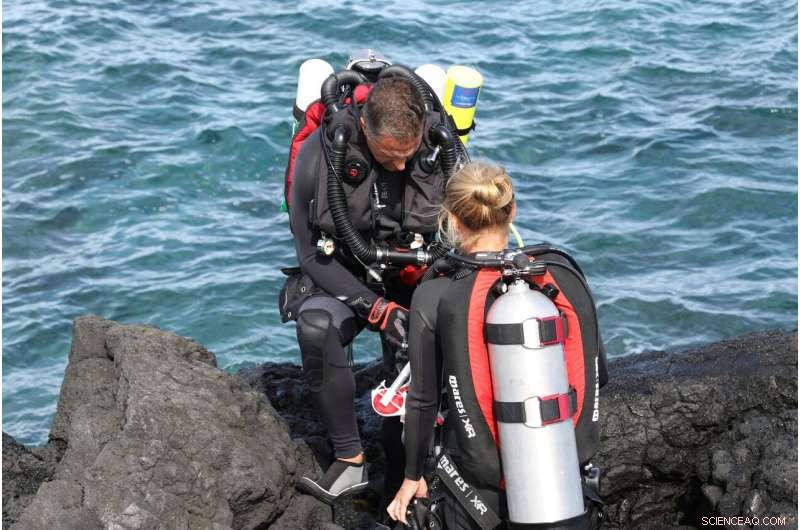
In this Sept. 13, 2019 foto, researchers prepare to dive on a coral reef on the west coast of the Big Island near Captain Cook, Hawaii. One of the state's most vibrant coral reefs thrives just below the surface in a bay on the west coast of Hawaii's Big Island. Her, on a remote shoreline far from the impacts of sunscreen and throngs of tourists, scientists see the early signs of what's expected to be a catastrophic season of coral bleaching in Hawaii. The ocean here is about three and a half degrees above normal for this time of year. Coral can recover from bleaching, but when it is exposed to heat over several years, the likelihood of survival decreases. (AP Photo/Caleb Jones)
-
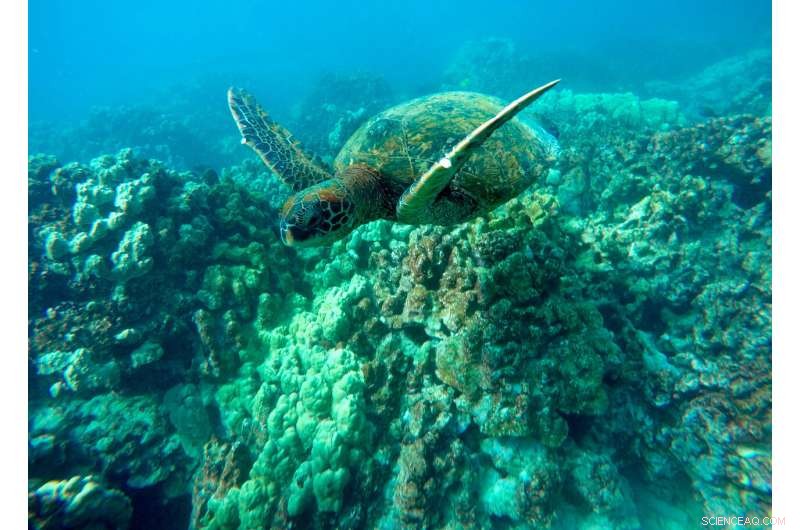
In this Sept. 11, 2019 foto, a green sea turtle swims near coral in a bay on the west coast of the Big Island near Captain Cook, Hawaii. Just four years after a major marine heat wave killed nearly half of this coastline's coral, federal researchers are predicting another round of hot water will cause some of the worst coral bleaching the region has ever seen. (AP Photo/Brian Skoloff)
-
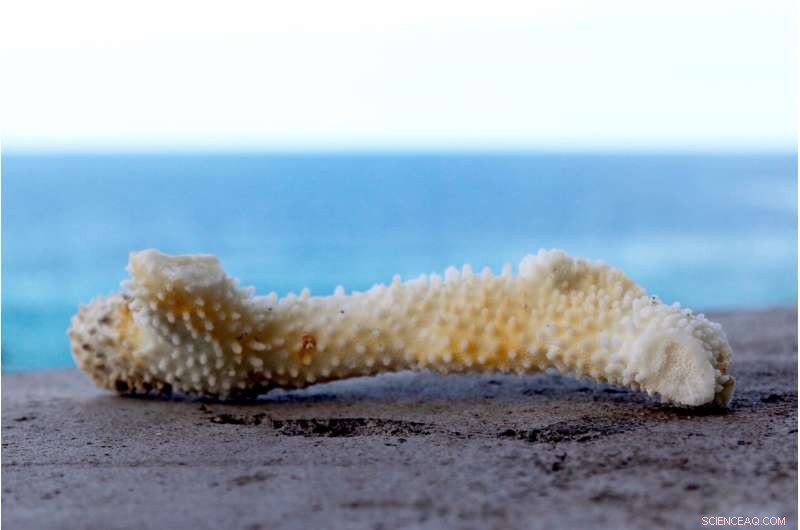
This Sept. 13, 2019 photo shows a chunk of bleached, dead coral shown on a wall near a bay on the west coast of the Big Island near Captain Cook, Hawaii. One of the state's most vibrant coral reefs thrives just below the surface in a bay on the west coast of Hawaii's Big Island. Her, on a remote shoreline far from the impacts of sunscreen and throngs of tourists, scientists see the early signs of what's expected to be a catastrophic season of coral bleaching in Hawaii. The ocean here is about three and a half degrees above normal for this time of year. Coral can recover from bleaching, but when it is exposed to heat over several years, the likelihood of survival decreases. (AP Photo/Caleb Jones)
-

In this Sept. 13, 2019 foto, ecologist Greg Asner, the director of Arizona State University's Center for Global Discovery and Conservation Science, reviews ocean temperature data at his lab on the west coast of the Big Island near Captain Cook, Hawaii. "Nearly every species that we monitor has at least some bleaching, " said Asner after a dive in Papa Bay. (AP Photo/Caleb Jones)
-

In this Sept. 16, 2019 foto, National Oceanic and Atmospheric Administration oceanographer Jamison Gove talks about coral bleaching at the NOAA regional office in Honolulu. U.S. federal researchers in Hawaii say ocean temperatures around the archipelago are on track to match or even surpass records set in 2015, the hottest year on record for the Pacific Ocean. They predict that heat will cause some of the worst coral bleaching and mortality the region has ever seen. (AP Photo/Caleb Jones)
-
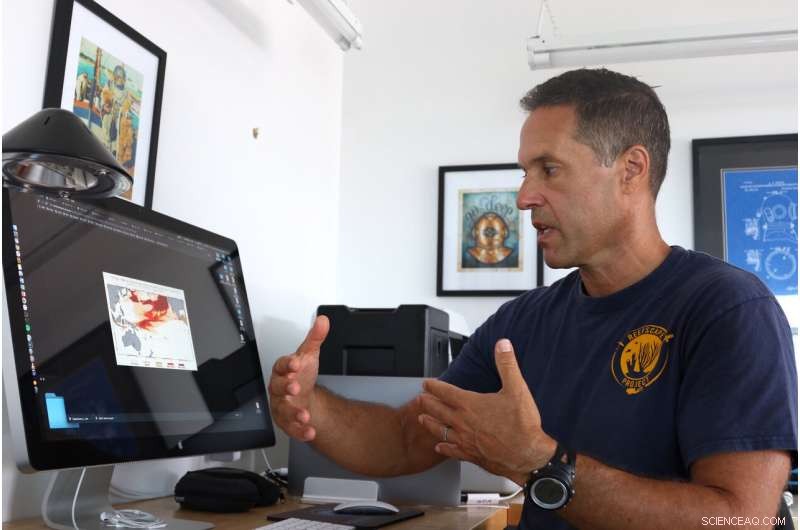
In this Sept. 13, 2019 foto, ecologist Greg Asner, the director of Arizona State University's Center for Global Discovery and Conservation Science, reviews ocean temperature data at his lab on the west coast of the Big Island near Captain Cook, Hawaii. "Nearly every species that we monitor has at least some bleaching, " said Asner after a dive in Papa Bay. (AP Photo/Caleb Jones)
The bay suffered widespread bleaching and coral death in 2015.
"It was devastating for us to not be able to do anything, " Punihaole Kennedy said. "We just watched the corals die."
© 2019 The Associated Press. Alle rettigheder forbeholdes.
 Varme artikler
Varme artikler
-
 NASA finder en vis fragmenteret styrke i Tropical Depression 05WNASAs Aqua-satellit afslørede nogle skytoptemperaturer i fragmenterede tordenvejr som kolde eller koldere end minus 70 grader (rød) Fahrenheit (minus 56,6 grader Celsius) på Tropical Depression 05W de
NASA finder en vis fragmenteret styrke i Tropical Depression 05WNASAs Aqua-satellit afslørede nogle skytoptemperaturer i fragmenterede tordenvejr som kolde eller koldere end minus 70 grader (rød) Fahrenheit (minus 56,6 grader Celsius) på Tropical Depression 05W de -
 Fossiltræer på Perus Central Andean Plateau fortæller en historie om dramatiske miljøændringerPaleontolog Edwin Cadena poserer ved siden af kæmpe, forstenet (permineraliseret) træ på det peruanske centrale plateau. Kredit:Carlos Jaramillo, Smithsonian Tropical Research Institute På en ek
Fossiltræer på Perus Central Andean Plateau fortæller en historie om dramatiske miljøændringerPaleontolog Edwin Cadena poserer ved siden af kæmpe, forstenet (permineraliseret) træ på det peruanske centrale plateau. Kredit:Carlos Jaramillo, Smithsonian Tropical Research Institute På en ek -
 Havniveauet vil fortsætte med at stige, efter at Paris-aftalens udledningstilsagn udløber i 2030Kredit:CC0 Public Domain Havniveauet vil fortsætte med at stige rundt om i verden længe efter, at de nuværende løfter om CO2-emissioner, der er givet gennem Paris-klimaaftalen, er opfyldt, og den
Havniveauet vil fortsætte med at stige, efter at Paris-aftalens udledningstilsagn udløber i 2030Kredit:CC0 Public Domain Havniveauet vil fortsætte med at stige rundt om i verden længe efter, at de nuværende løfter om CO2-emissioner, der er givet gennem Paris-klimaaftalen, er opfyldt, og den -
 Fødevaresystemer er foder til at begrænse byernes miljøpåvirkningerKredit:CC0 Public Domain Fokus på urbanisering som en vigtig drivkraft for miljøændringer i det 21. århundrede, forskere ved Princeton University har skabt en ramme til at forstå og sammenligne by
Fødevaresystemer er foder til at begrænse byernes miljøpåvirkningerKredit:CC0 Public Domain Fokus på urbanisering som en vigtig drivkraft for miljøændringer i det 21. århundrede, forskere ved Princeton University har skabt en ramme til at forstå og sammenligne by
- Sidste istid:Nedbør forårsagede maksimal fremrykning af alpine gletschere
- Slægtsforskningsside vidste ikke, at det blev brugt til at søge seriemorder
- Hvad er i midten af Saturn?
- Batterifri smart legetøj bevæger sig tættere på kommerciel virkelighed
- Ultrahurtige elektroner i magnetiske oxider:En ny retning for spintronics?
- Ny forskning kan hjælpe renere energiteknologier


